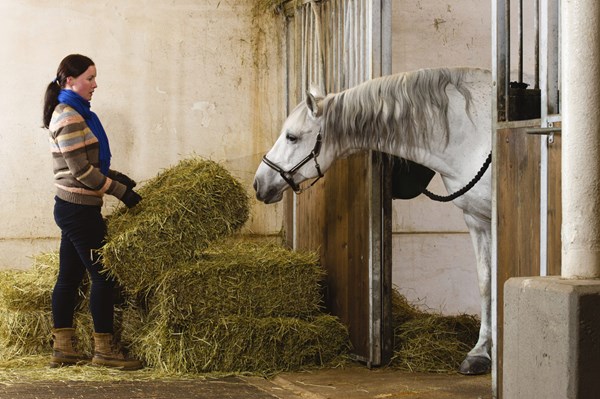 Credit: Thinkstock You need to get the hay into the horse, but what is the best method to do this for the health of the horse and to avoid wasting hay?
Credit: Thinkstock You need to get the hay into the horse, but what is the best method to do this for the health of the horse and to avoid wasting hay?With all the options available for getting hay into your horse—think about it: nets, feeders, mangers, bags, automatic feeders, from the ground—what’s the best way to feed your horse hay?
“Because each horse and farm are different, there is no one best way to feed horses,” says Kathleen Crandell, PhD, Kentucky Equine Research nutritionist. “Looking at all the alternatives will help fine-tune the feeding program by deciding which is the most appropriate for the horse and farm.”
Below is a quick-reference guide highlighting the benefits of four different types of feeding devices.
Hay Nets and Slow Feeders
- Hay nets can be weighed easily when they’re filled and transported efficiently to stalls.
- Nets facilitate hay-soaking for horses with equine metabolic syndrome, insulin resistance, or chronic laminitis.
- Slow-feeders mimic grazing, keeping horses entertained if confined to stalls or drylots.
- Hay nets with small mesh sizes stop horses from pulling out a bunch of hay, shaking it around, and generating dust and other airborne particles, which is deleterious for horses with inflammatory airway disease or heaves.
Outdoor Feeders
- In areas with sandy soils, spreading hay on the ground is not advised. To minimize the ingestion of sand and chances of sand colic, feed hay in some type of feeder.
- Ensure the feeder is placed at an appropriate height, free from sharp edges, large enough to accommodate all horses in the paddock, protected from rain (to avoid wastage and molding), and easy to clean.
Feeding from the Ground
- Spreading the hay on the ground or in the stall can promote the drainage of mucus from horses’ airways. This is beneficial for horses with breathing problems such as heaves.
- In groups of horses, offering various piles of hay will also ensure all horses have access to the forage. This is particularly salient for horses low in the pecking order that get excluded.
- If round bales are the only option, consider using round-bale feeders with small mesh sizes to keep the hay off the ground, minimize wastage, and decrease the chances horses will plunge their muzzles into the bale, which is less than ideal for respiratory health.
Note that grazing muzzles can be used even in stalls to slow intake of hay.
Article courtesy of Kentucky Equine Research. Visit equinews.com/newsletters to subscribe to The Weekly Feed, KER’s award-winning equine nutrition newsletter.



